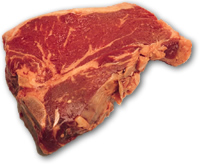This page has been archived and is being provided for reference purposes only. The page is no longer being updated, and therefore, links on the page may be invalid.
|
Compounds May Help Produce Juicier Meat
By Sharon DurhamOctober 27, 2005
Getting a juicy cut of meat isn’t always the easiest of tasks. Juiciness is governed by how much fat--called marbling fat--is woven within the muscles. But the likelihood of getting a juicy steak or chop may increase in the future, thanks to Agricultural Research Service (ARS) scientists who are studying a class of compounds that increase marbling fat in livestock.
ARS physiologist Gary Hausman and his colleagues at the Animal Physiology Research Unit in Athens, Ga., in collaboration with University of Georgia researchers, developed a method that can increase marbling fat by as much as 3.5 percent by adding the compound as a feed supplement for swine.
Increased marbling fat improves meat quality factors such as flavor intensity, juiciness and texture. Decreasing fat in meats has been a goal of breeders in the past, but it results in meat that is not considered desirable by consumers.
Some of the compounds, called thiazolidinediones, are currently approved by the Food and Drug Administration for use in diabetic people to control glucose levels. However, none are currently approved by FDA for use in livestock with the intent of changing food composition.
In research studies, the compounds were mixed into livestock feed with relative ease during animal production. Most of the research focused on swine, but the compounds may also improve marbling fat in beef cattle as well.
Enhanced marbling fat would increase carcass value, benefitting the livestock industry and possibly providing increased profitability for producers.
Other technologies exist for boosting marbling fat, but they are costly and the effectiveness varies. A patent for the new technology has been filed and foreign licensing rights are available.
ARS is the chief scientific research agency of the U.S. Department of Agriculture.

